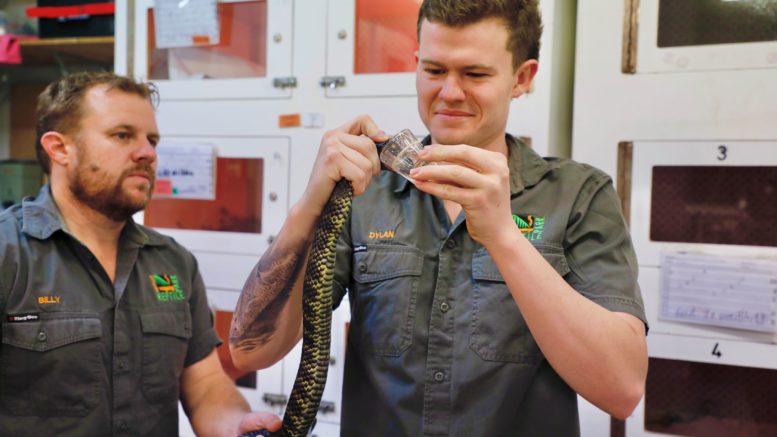Most kids dream of becoming firefighters or doctors, but for Dylan Wallis, his passion lies with snakes.
From a young age, Wallis has been captivated by the slithering creatures and his dedication has led him to become an integral part of the venom program at the renowned Australian Reptile Park.
Since beginning his career with the Park over six years ago, he’s been lucky enough to work his way up the ranks to become a key part of the venom program.
For the past two and a half years, he’s been trained by the most experienced venom keepers in Australia and has enrolled into intensive training to become a qualified venom keeper.
Throughout his training, Wallis has had to learn snake husbandry, how to process the raw venom, handling the venom vials and finally, learn and understand snake behaviour and act accordingly when handling the snake.
“I was so nervous milking my first snake,” he said.
“My adrenaline was at an all-time high, but I smashed through it and couldn’t have been prouder of myself.
“Now over two years on, I’m loving every second of it.
“The passion and drive that started my career at the Park was of course my love for snakes, but words cannot explain how rewarding it is to know that I’m contributing to the venom program that saves over 300 lives each year.”
The Australian Reptile Park is the only facility in the world that milks Australian terrestrial land snakes for the production of antivenom.
With 2,000 reported snake bites occurring annually in Australia, having rookies undergo rigorous training to contribute to the venom program becomes crucial, as it directly translates to saving an estimated 300 lives each year.
This is done with the help of CSL Seqirus, which transforms the raw venom into the final product of lifesaving antivenom.
Handling Australia’s most venomous snakes such as the Eastern Brown and the Coastal Taipan – the deadliest of them all – is no easy feat.
Snakes such as the Coastal Taipan have the capacity to kill a human in single bite, so being a venom keeper is easily one of the most dangerous jobs in Australia and comes with many risks.
Safety is of the utmost importance and there is no room for error.
Operations Manager Billy Collett, who has taken Wallis under his wing to mentor him, said the young man was progressing well with his training.
“He’s gone from milking Tiger snakes and King Brown snakes, to now moving onto milking common Death Adders,” Collett said.
“Eventually, he will get the opportunity to milk Eastern Brown snakes and finally, the most venomous snake in Australia, the Coastal Taipan.
“Venom training is extremely demanding and requires a lot of patience.”
With a few more years left of his training program, Wallis will eventually be signed off to care for, handle and extract venom from all five groups of snakes which contribute to the Park’s venom program; Tiger snakes, King Brown snakes, common Death Adders, Eastern Brown snakes and Coastal Taipans.
In early 2023, the Australian Reptile Park commenced construction on a new state-of-the-art venom milking facility where visitors will be able to walk through and witness the lifesaving work first-hand.
The NSW State government has committed $300,000 to the project with ground works well and truly underway.
Source:
Australian Reptile Park



